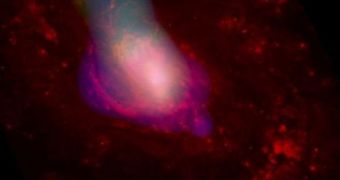Astrophysicists are convinced that there is something they are not seeing in the Cosmos: a source for the X-ray background that dedicated telescopes are observing. Now, they propose that black holes smothered in dust, hidden at the cores of active, but undetected galaxies, are responsible for this.
This proposal was very interesting to many the moment it was made, but it had no evidence to back it up. In a new study, experts using a space observatory were able to confirm that such a population of active galaxies in fact exists.
In order to be correct, the theory entails the presence of galaxies that are powered by supermassive black holes at their cores. This has been observed in quasars, the active nuclei of distant galaxies.
But experts using the NASA Swift satellite to confirm the prediction run into a small problem – how exactly do you go about detecting undetectable galaxies? They quickly learned that these objects emitted X-rays, but only in extremely small amounts.
In reality, it wasn't that the objects were incapable od producing massive bursts of X-rays. The thing is that most of their emissions were absorbed by the background. As such, the team could only observe about 12 such objects.
Still, this small number was sufficient for experts to draw a series of conclusions based on their studies. The most important was that these smothered galaxies may in fact be all over the place, and account for as much as 20 percent of all active galaxies in the Universe.
“These heavily shrouded black holes are all around us. But before Swift, they were just too faint and too obscured for us to see,” explains Swift principal investigator Neil Gehrels, quoted by Daily Galaxy.
The expert is based at the NASA Goddard Space Flight Center (GSFC), in Greenbelt, Maryland, and is also a coauthor of the new study detailing the findings. The work is published in the February 10 issue of the esteemed Astrophysical Journal.
“These extremely obscured active galaxies are very faint and difficult to find. Out of a sample of 199 sources, we detected only nine of them,” explains lead study author Davide Burlon.
“But even Swift's BAT (Burst Alert Telescope) has trouble finding these highly absorbed sources, and we know that the survey undercounts them,” adds the expert, who is a graduate student at the Max Planck Institute for Extraterrestrial Physics, in Munich, Germany.
“When we factored this in, we found that these shrouded active galaxies are very numerous, making up about 20 to 30 percent of the total,” the expert concludes.
Analysts say that the new discovery might force investigators to reconsider at least some of the traits they currently attribute to dark matter and dark energy.

 14 DAY TRIAL //
14 DAY TRIAL //